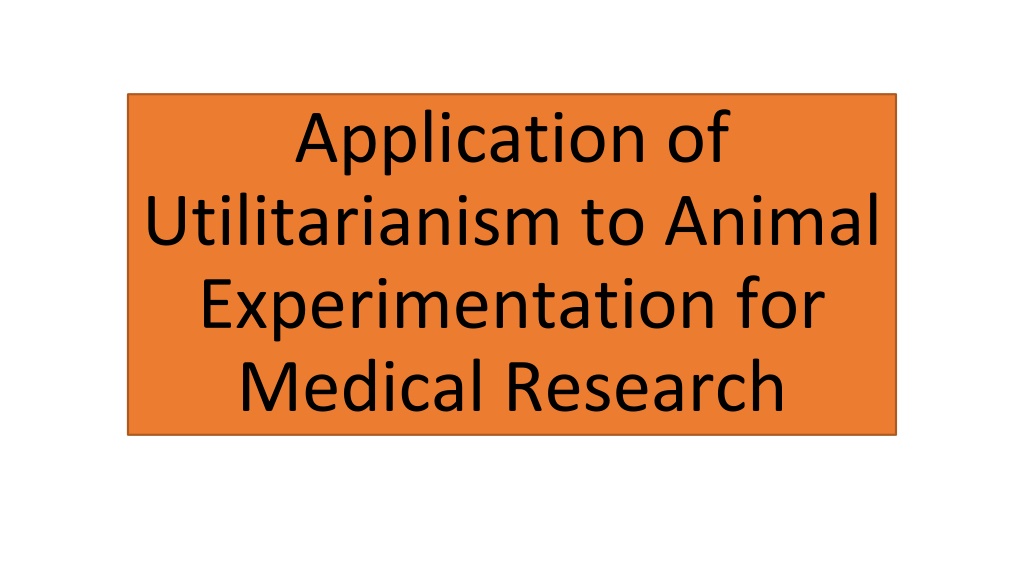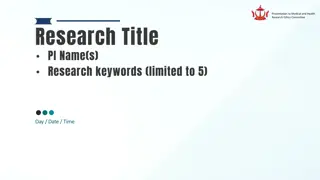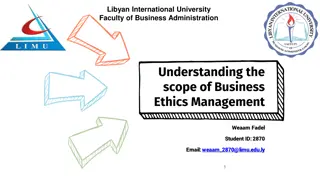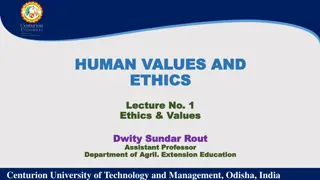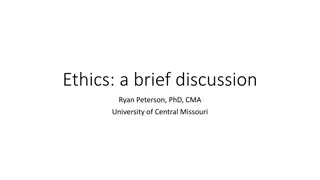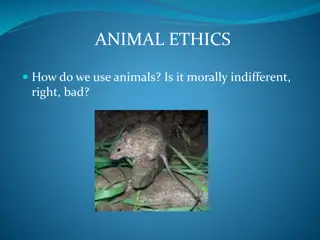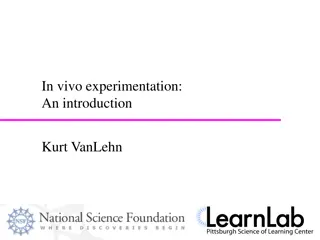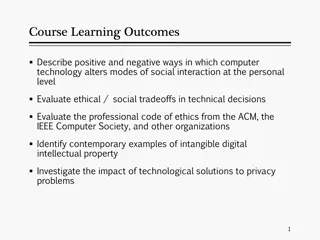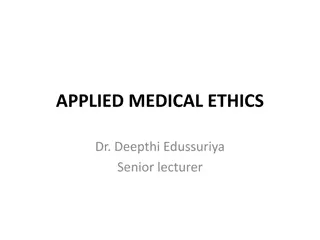Ethics of Animal Experimentation in Medical Research
Exploring the application of utilitarianism to animal experimentation for medical research, this content delves into the history of vivisection, animal rights activism, and the work of historical figures like Claudius Galen in advancing medical understanding through dissection. The ethical considerations and controversies surrounding the use of animals in scientific research are examined within the framework of utilitarian philosophical theories.
Download Presentation

Please find below an Image/Link to download the presentation.
The content on the website is provided AS IS for your information and personal use only. It may not be sold, licensed, or shared on other websites without obtaining consent from the author. Download presentation by click this link. If you encounter any issues during the download, it is possible that the publisher has removed the file from their server.
E N D
Presentation Transcript
Application of Utilitarianism to Animal Experimentation for Medical Research
Theme 3 Teleological Ethics F: Application of the theory The application of Bentham s Act Utilitarianism and Mill s Rule Utilitarianism to both of the issues listed below: 1. animal experimentation for medical research 2. the use of nuclear weapons as a deterrent
Some Key Words for you Vivesection: the practice of performing operations on live animals for the purpose of experimentation or scientific research Animal Aid: is one of the world s longest established animal rights groups, having been founded in 1977. They campaign peacefully against all forms of animal abuse and promote cruelty-free living. Dissection: the action of dissecting a body or plant to study its internal parts. Understanding Animal Research: Understanding Animal Research is a not-for-profit organisation that explains why animals are used in medical and scientific research. They aim to achieve a broad understanding of the humane use of animals in medical, veterinary, scientific and environmental research in the UK. We are funded by our members who include universities, professional societies, industry and charities.
Claudius Galen Galen was born in 131 AD. He was a gifted intellect who studied at the famous medical school in Alexandria in Egypt. At the age of 28, Galen became the surgeon to a school of gladiators but in 161 AD he moved to Rome apparently with the sole intention of seeking fame and fortune. He certainly achieved his fame but for some Romans this became too much. As a Greek, many Romans viewed Galen with suspicion and in 166 AD, he was forced to flee the city. Two years later he went back to the city in response to an invitation by the emperor. With this protection, Galen remained in the city until his death, aged about 70, in 201 AD. Galen revived the methods favoured by Hippocrates and other Greek doctors who lived at the time of Hippocrates. He put great emphasis on clinical observation examining a patient very thoroughly and noting their symptoms. Galen also accepted the view that disease was the result of an imbalance between blood, phlegm, yellow bile and blood bile. Galen also believed in the healing power of nature and he developed treatments to restore the balance of the four humours. Galen believed in the use of opposites if a man appeared to have a fever, he treated it with something cold; if a man appeared to have a cold, he would be treated with heat. People who were weak were given hard physical exercises to do to build up their muscles. People who had breathing problems due to a weak chest were given singing exercises.
Galen extended his knowledge of anatomy by dissecting pigs and apes and studying their bone structure and muscles. Galen was also interested in human anatomy but there is no evidence that he dissected human bodies though rumours persisted that he did. In On Anatomical Procedures , Galen advised his students to dissect apes but take whatever opportunities that existed to study the human body. Galen also studied how the body worked, concentrating on the movement of blood and the working of the nervous system. For the latter, he experimented with the spinal cords of pigs. Galen s influence was great. Protected by the emperors, he could work free from his jealous rivals in Rome. Galen also believed that his knowledge should be shared and he was a prodigious writer of books. These books were still being used in the Middle Ages and, for many medical students, they were the primary source of information on medicine.
William Harvey Harvey was an English physician who was the first to describe accurately how blood was pumped around the body by the heart. William Harvey was born in Folkestone, Kent on 1 April 1578. His father was a merchant. Harvey was educated at King's College, Canterbury and then at Cambridge University. He then studied medicine at the University of Padua in Italy, where the scientist and surgeon Hieronymus Fabricius tutored him. Fabricius, who was fascinated by anatomy, recognised that the veins in the human body had one-way valves, but was puzzled as to their function. It was Harvey who took the foundation of Fabricius's teaching, and went on to solve the riddle of what part the valves played in the circulation of blood through the body.
On his return from Italy in 1602, Harvey established himself as a physician. His career was helped by his marriage to Elizabeth Browne, daughter of Elizabeth I's physician, in 1604. In 1607, he became a fellow of the Royal College of Physicians and, in 1609, was appointed physician to St Bartholomew's Hospital. In 1618, he became physician to Elizabeth's successor James I and to James' son Charles when he became king. Both James and Charles took a close interest in and encouraged Harvey's research. Harvey's research was furthered through the dissection of animals. He first revealed his findings at the College of Physicians in 1616, and in 1628 he published his theories in a book entitled 'Exercitatio Anatomica de Motu Cordis et Sanguinis in Animalibus' ('An Anatomical Study of the Motion of the Heart and of the Blood in Animals'), where he explained how the heart propelled the blood in a circular course through the body. His discovery was received with great interest in England, although it was greeted with some scepticism on the Continent. Harvey was also the first to suggest that humans and other mammals reproduced via the fertilisation of an egg by sperm. It took a further two centuries before a mammalian egg was finally observed, but nonetheless Harvey's theory won credibility during his lifetime. Harvey retained a close relationship with the royal family through the English Civil War and witnessed the Battle of Edgehill. Thanks to Charles I he was, for a short time, warden of Merton College, Oxford (1645 - 1646). He died on 3 June 1657.
What about today? What animals are used in experiments today? According to the latest Government figures (for 2016), a total of 3.9 million experiments were completed in Great Britain during 2016. Of these, 1.9 million (49%) related to the creation or breeding of genetically altered animals who were not used in further experiments. The remaining 2.0 million (50%) were other experiments on animals. Almost 700,000 animals were subjected to experiments that even the researchers considered had caused them moderate or severe suffering. Animals used in the UK included mice (1.2 million experiments), rats (238,841 experiments), birds (149,97 experiments), rabbits (15,431 experiments), guinea-pigs (26,186 experiments), monkeys (3,569 experiments), dogs (4,932 experiments), cats (190 experiments), horses (8,948 experiments), sheep (47,904 experiments), pigs (5,358 experiments), and fish (286,600 experiments). Of the 2.0 million experiments conducted on animals, 55% (1.1 million experiments) were in the area of basic research much of it driven by the curiosity of university researchers.
49% of experiments were conducted in universities, often using taxpayers funds. Only 13% of experiments were apparently required by regulators. In 2016, 89% of experiments conducted on monkeys used animals who were imported from outside the EU. Experiments are still being conducted for toxicological tests where there are valid non-animal alternatives available. This includes: skin irritation (252 tests in 2016) eye irritation (128 tests in 2016) acute lethal toxicity tests (11,530 tests in 2016) pyrogenicity (fever) tests (2,472 tests in 2016) on live rabbits. https://www.crueltyfreeinternational.org/why-we-do-it/facts-and-figures-animal-testing
In 1997 Dr Jay Vacanti and his team grew an ear on the back of a mouse What s the issue then? Animal experiments are widely used to develop new medicines and to test the safety of other products. Many of these experiments cause pain to the animals involved or reduce their quality of life in other ways. If it is morally wrong to cause animals to suffer then experimenting on animals produces serious moral problems. Animal experimenters are very aware of this ethical problem and acknowledge that experiments should be made as humane as possible. They also agree that it's wrong to use animals if alternative testing methods would produce equally valid results.
Two positions on animal experiments In favour of animal experiments: Experimenting on animals is acceptable if (and only if): suffering is minimised in all experiments human benefits are gained which could not be obtained by using other methods
Against animal experiments: Experimenting on animals is always unacceptable because: it causes suffering to animals the benefits to human beings are not proven any benefits to human beings that animal testing does provide could be produced in other ways
Harm versus benefit The case for animal experiments is that they will produce such great benefits for humanity that it is morally acceptable to harm a few animals. The equivalent case against is that the level of suffering and the number of animals involved are both so high that the benefits to humanity don't provide moral justification. The three Rs The three Rs are a set of principles that scientists are encouraged to follow in order to reduce the impact of research on animals. The three Rs are: Reduction, Refinement, Replacement.
Reduction: Reducing the number of animals used in experiments by: Improving experimental techniques Improving techniques of data analysis Sharing information with other researchers Refinement: Refining the experiment or the way the animals are cared for so as to reduce their suffering by: Using less invasive techniques Better medical care Better living conditions Replacement: Replacing experiments on animals with alternative techniques such as: Experimenting on cell cultures instead of whole animals Using computer models Studying human volunteers Using epidemiological studies
Animal Aid Versus Understanding Animal Research Against animal experiments Support for animal experiments Read the article and watch the video http://animalaid.wpengine.com/ education/education- resources/investigating-animal- research/ Highlight five arguments against animal medical experiments UAR http://www.understandinganim alresearch.org.uk/schoolzone/rig hts-and-wrongs/
Animal Experimentation for Medical Research ACT UTILITARIANISM RULE UTILITARIANISM greatest happiness for the greatest number promotes pleasure and avoids pain Bentham The question is not, can they reason? Nor, can they talk? But can they suffer? P R R I C Extent D Higher and lower pleasures Harm principle Strong Rule Utilitarianism
